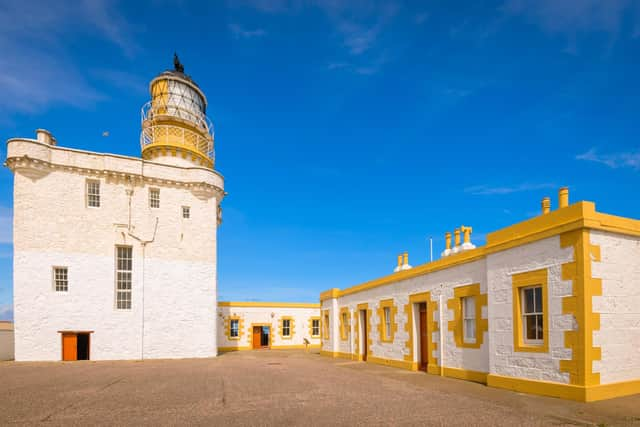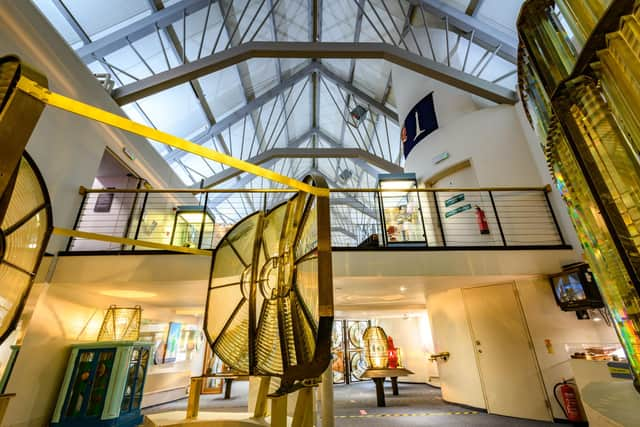Spring Travel: discover The Museum of Scottish Lighthouses
Today the site is home to The Museum of Scottish Lighthouses, which welcomes hundreds of visitors each year thanks to its dramatic coastal views, history, and peculiarity.
The charity-run centre is one of Scotland’s most unusual attractions, telling the story of the mainland’s first operational lighthouse, which was built in the middle of a 16th-Century castle – and is the only lighthouse inside another building.
Advertisement
Hide AdAdvertisement
Hide AdThe tale began in 1570 when Kinnaird Head Castle was constructed by Sir Alexander Fraser, 8th laird of Philorth – the ancient parish name – as part of the Fraser’s plans to acquire the land before later developing the harbour town.


The structure dominated the headland for more than 200 years before being abandoned and left in a state of near ruin.
“Its owner, Lord Saltoun ofAbernethy – a title inherited by the Frasers of Philorth – had ambitions to make it into a private lighthouse from which he would claim the lighting dues,” explains a member of The Museum of Scottish Lighthouses’ management team.
“It is likely that it was through Lord Saltoun that the committees in Westminster became aware of Kinnaird Head as an ideal site for a lighthouse.”
The castle was sold to the National Lighthouse Board and converted into a lighthouse designed by Edinburgh engineer Thomas Smith in 1787. While it was the most powerful lamp of its day, it quickly became outdated.


Smith’s grandson, Robert Stevenson, famed for lighting up Scotland’s coastlines in the 18th and 19th centuries, and whose family built more than 93 lighthouses in 150 years, began carrying out major structural works three decades later.
The museum member points to Stevenson’s famous feat of engineering at the Bell Rock Lighthouse off the coast of Arbroath. It stood on a rock submerged in water for most of the day, and was situated 12 miles offshore.Kinnaird Head, meanwhile, was simply a timber lantern perched upon a deteriorating stronghold.
The member explains: “Stevenson’s original intention for Kinnaird Head was to demolish the castle and build a new lighthouse tower in its place, but clearly this was not carried through.
Advertisement
Hide AdAdvertisement
Hide Ad“It has been suggested that his friend Sir Walter Scott persuaded him to retain the castle as it looked quaint with a light above it. Robert instead designed a new lighthouse tower which was to be built through the middle of the castle structure.”
The build was completed in 1824 and included new foundations and a spiral staircase to the lamp which flashed every 15 seconds to warn sailors of the headland.
The lighthouse is still in full working order, although it only lights up on special occasions, including the 100th Armistice Day, and the Queen’s Platinum Jubilee in 2022, as well as in support of causes such as Parkinson’s disease and children’s charities.
Much more of both the castle and lighthouses’ history has been showcased through displays, exhibitions and tours held by the family-friendly museum since 1995.
Visitors can climb the spiral staircase to the top of the lighthouse and discover how its keepers lived by exploring their preserved quarters inside. Fully-trained and friendly tour guides tell the tales of Kinnaird Head’s past keepers, including the first –James Park – who kept a cow on the castle grounds as part of his wages.
The former sea captain was tasked with cleaning the 17 whale oil lamps and reflectors every three to four hours until his retirement in 1797.
The venue also houses the world’s largest collection of Fresnel lenses, as well as the largest collection of lighthouse objects and archives.
“Visitors can expect a wonderful experience learning about the history of Lighthouses in Scotland, light keeping, the Stevenson family of engineers, and the history of the Northern Lighthouse Board,” the management team member says.
Advertisement
Hide AdAdvertisement
Hide Ad“The guided tour of the castle and lighthouse is unique in the country, allowing the visitors to see the only working mechanism running the 3.5-tonne lens, a hyper-radial lens – one of only two remaining today.”
There is a souvenir shop stocked with interesting gifts concerning lighthouses and the local area.
In addition, the popular attraction also serves as a quirky venue for brides and grooms seeking a nautical wedding theme, and its staff can provide a tailored service.
During the summer months, ceremonies can even be held on the castle roof with Robert Stevenson’s tower being the star guest of the show. Along with the Moray Firth and North Sea as a backdrop, the idiosyncratic surroundings would surely mark a most unusual big day and yield some unique photographs.
◆ The museum is set to reopen for the spring season with new objects on display from Friday, 29 March
◆ Guided tours of the castle and lighthouse last around 45 minutes and run from 10am to 4pm
◆ Opening times are 10am to 5pm, Wednesday to Sunday.
◆ To find out about upcoming events, keep an eye on the centre’s Facebook page at www.facebook.com/LighthouseMus
◆ To find out more about The Museum of Scottish Lighthouses, go online to lighthousemuseum.org.uk